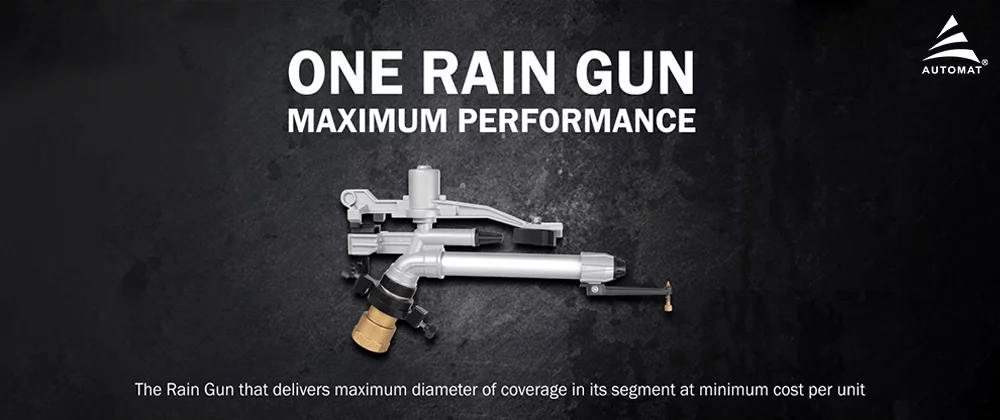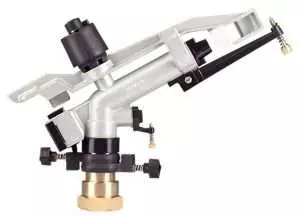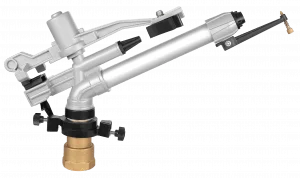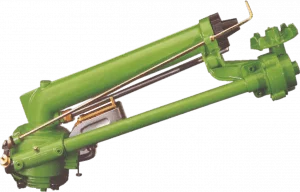
What is Raingun
A Rain gun is a high-performance micro-irrigation device and it is designed for a variety of uses and applications where relatively high flows and extended radius of the water throw are desired.
Rain gun sprinkler is available with an operating pressure of 2.0 to 7.5 kg/cm2 and flow of 3 to 30 lps. Most of them have nozzle diameters ranging from 10 to 30 mm and a wetting radius of around 27- 60 meter.
Features of Raingun
-
- Used for irrigating the large area in one time.
Rain guns are used for irrigating large field areas at once. The guns irrigate the land with minimum labor and electricity requirements. While rain gun irrigation, pests, and insects get washed away. - Available with an adjustable jet breaker
The adjustable jet breaker allows droplet size & impact adjustment facility for delicate crops. It provides uniform irrigation. - Minimum components to operate the system
Component necessities are minimum and the components are lightweight and sturdy with high workmanship. Thus, there are maintenance requirements even after a long period of use. - Available with interchangeable nozzles
The interchangeable nozzles provide the flexibility of irrigation for various crop and soil stags. Interchangeable nozzles are suitable for all types of soil/crop stages.
- Used for irrigating the large area in one time.
Read more : A Comprehensive Guide to Choosing the Best Sprinkler Irrigation System
Applications
- For Irrigation of field crops i.e. Sugarcane, Wheat, Bajra (Sorghum), Soybean, Maize, Pulses, etc.
In well-grown sugarcane, it is very hard for the farmers to spray in the inner field. They have fertilizer tank and a venture assembly. Thus, fertilizers and pesticides can be sprayed easily with hardly any labor. - Tea, Rubber & Coffee Plantation
The rain guns are highly admired by the clients because of their easy installation, corrosion resistance, high performance, and numerous other features. Thus these are very useful for Tea, Rubber and Coffee Plantations. - Fodder Crops & Green Pastures
Another very important use is in Fodder and Green Pasture irrigation. It can cover an area of around one acre by sprinkling from one position in just 2-3 hours. With the portable installation, it can cover the entire farm by moving the system. - Dust Suppression in mines & Thermal power station
Rain Guns can be used for dust suppression in mining and its related operations. It comes with a pump set and high-pressure pipes which help in controlling dust.
Read more : Increase Yield of the Crop Using Sprinklers
Components
The rain guns are inclusive of several components. All the components are lightweight, sturdy and easy to install.
Main Line Pipes
• PVC
• HDPE
• Aluminum
Sub‐main Line Pipes?
• Rain Guns
• Impact Type
• Pelican Gear Drive Type
Skipper
• Tripod Stand for Rain Gun
• Tri-Pod Stand
Fittings & Accessories (Camlock Fittings)
• Female Coupling
• Male Barbed Coupling
• Male Coupling
• End Plug
Types of Rain Gun
There are 6 Types of Rain gun:
1. Impact Type
• Available in 1¼” BSP Available in 1½” BSP
• Female Thread Connection Female Thread Connection
2. Penguin Pelican
• Performance is based on ideal conditions of Temperature, wind velocity and Humidity.
• Available in 2” BSP Female Thread Connection

3. Flamingo Rain Gun
• It also provides the same performance as Penguin Pelican.
• Gear Drive Type
• Available in 1½” BSP Female Thread Connection

4. Skipper
• Standard Nozzle Size
• Manufactured as per ISO‐7749‐1&2 specifications
• Performance is based on ideal conditions of Temperature, wind velocity and Humidity.
• Available in 2½” BSP Female Thread Connection

5. Mariner
• Performance is based on ideal conditions of Temperature, wind velocity and Humidity.
• Standard Nozzle Size
• Manufactured as per ISO‐7749‐1&2 specifications
• Design Parameter for Rain Gun System
• Square Spacing
• D = D1 = 1.41G
• D = Spacing of Rain Gun on Lateral D1 = Spacing between the Laterals G = Jet Length/Throw of Rain Gun
6. Triangular Spacing
• D = 1.73G D1 = 1.50G
• D = Spacing of Rain Gun on Lateral D1 = Spacing between the Laterals G = Jet Length/Throw of Rain Gun
• The above are recommended for Pipe Length of 200 to 300 mtr Length from water source. In case length exceeds the above 300 mtr, select the next pipe size.
Installation of Rain Gun
Rain Gun on the Tripod Stand can be screwed directly or with the “CAM LOCK” quick coupling fittings as shown below: –
Precautions to Be Taken While Installation & Dismantling of Rain Gun:
1. While installing, it should be ensured that Rain Gun sprinkler is properly tightened/ screwed on the Tripod.
2. The arc adjustment can be made if required, with the help of adjustment rings at the bottom.
3. The nozzle size should be according to designed rating while replacing the nozzle using the right tool.
4. While sprinkler is in rotation, particularly in case of impact Rain Gun, one should stay away about 1mtr to avoid any harm from its fast reverse rotation.
5. In case it is shifted on quick coupling, handle it with care and avoid slipping of the same from hands, otherwise, few plastic components may get damaged.
6. To make the droplet size bigger depending upon the need of location/ crop stage, use the diffuser screw for the same.
7. Avoid its more use, in case of high wind velocity.
8. In case Rain Gun is non rotating, please contact the nearest dealer to analyze the cause & its rustication.
9. The technician should use the recommended tools for the opening of different parts.
In India, 61.38 percent is still under rainfed agriculture. It’s important to implement modern agriculture devices to make farming more efficient and easy.Automatworld provides the best automat irrigation services. Know more and contact us any time.




